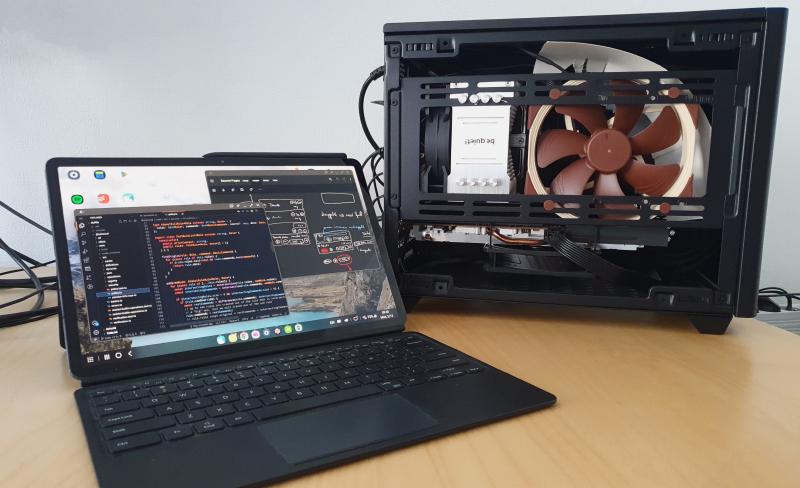The problem
My requirements are as follows:
- My main development environment has to be Linux. (Not just WSL, I want a proper Linux desktop environment.)
- I like to sketch stuff and draw diagrams. Paper works, but it gets disorganized really quickly. A digital device allows me to keep my notes organized and you can have an infinite canvas with nice colors and edit history. (Note: I don’t think there are good apps like this on Linux.)
- I want to build my own desktop. You can get a lot more performance for your money, and I can hand-pick each component to my liking (e.g. a good CPU, a mid-tier GPU, stellar Linux support).
- While I spend most of my time working from home, I do have to work in other places sometimes. I don’t want to maintain duplicate environments.
Requirement 2 suggests a tablet, 3 suggests a desktop, and 4 suggests a laptop. A windows laptop-tablet hybrid may be a compromise solution but I tried it and did not like it 1.
The solution
I have two devices:
- A desktop I built myself, which runs Linux.
- A Samsung Tab S7+, on which I run OneNote.
This setup satisfies requirements 1, 2 and 3. But how do I satisfy requirement 4? It’s a combination of three things:
- code-server, which lets you run Visual Studio Code in any browser.
- DeX mode on the Samsung tablet, although not technically required, gives me a traditional desktop environment. I also have the keyboard accessory.
- A bunch of networking configuration so I can reach my desktop from the internet. I only expose a single SSH port, and use SSH tunnels for anything else. (I use duckdns and JuiceSSH Pro to make it work).
This allows me to remotely connect with code-server (running on my desktop) through an SSH tunnel. In the end I’m able to work using the exact same editor as if I were on my desktop. This isn’t rocket science of course, it’s kinda like a home-built version of Github Codespaces where the server lives in your house.
This is fine for “simple” development where you never leave your IDE or terminal. Web development is a little harder because you really want to debug your frontend using devtools. While forwarding the ports to vite (or whatever you want to use) is no problem, most browsers on Android assume you do all your debugging work remotely via USB or the network. The solution is Kiwi Browser, which has full devtools available.
Conclusion
I’ve been using this setup for more than 2 years now and I really like it. It’s not for everyone as it requires a little work to set up and maintain, but for me it combines the best of Android with the best of (Desktop) Linux leading to a very smooth experience.
If you have any questions about this setup, feel free to contact me!
I once had an HP ZBook Studio G5, which seemed like a powerful laptop with a nice large pen-supported touchscreen. One problem, Linux support was really sketchy. I really tried to make it work, even manually compiling chromium to include Wayland support. Even then I couldn’t find a good note-taking app. So I settled on Windows with WSL but just plain didn’t like it. Then one day I opened my laptop to a big advert for some XBox service and that settled it – no more Windows. ↩︎
